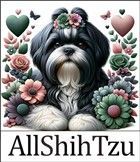Shih Tzu Shedding
Overview:
The Shih Tzu, celebrated for its luxurious coat, is often mistakenly thought to be a breed that doesn't shed. This article will clarify the differences between hair and fur and single vs double coats, debunk the myth of the non-shedding Shih Tzu, and explore how factors like seasons and pregnancy affect shedding patterns. We will also address coat issues that may cause abnormal shedding and hair loss.
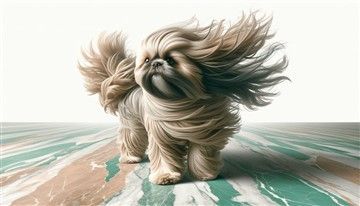
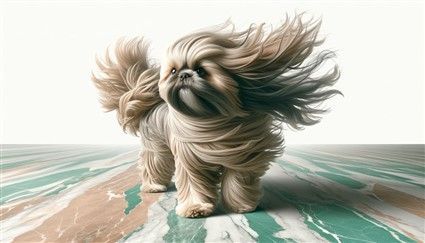
Please note: AllShihTzu is reader-supported. Some links below are affiliate links, meaning we may earn a small commission on products through these, at no extra cost to you.
Hair vs Fur:
As you probably know, the Shih Tzu has hair, not fur. Scientifically, both hair and fur are made of the same material: keratin. The primary differences are:
Growth Cycles: Hair typically has a longer growth cycle than fur, meaning it grows longer over a more extended period before falling out (thus a light shed). This characteristic is why breeds with hair, like the Shih Tzu, often requires regular haircuts and grooming to keep their coats manageable and healthy. Fur, on the other hand, has a shorter growth cycle, leading to more frequent shedding.
Texture and Length: The texture and length of hair and fur can also vary significantly. Dog hair is usually finer than fur and can be either straight, wavy, or curly, growing to considerable lengths if not trimmed. Fur tends to be denser and comes in various lengths and textures, from the short and sleek coats of Boxers to the thick, double coats of German Shepherds.
Allergies: A common misconception is that dogs with hair are hypoallergenic, while those with fur are not. In reality, allergies are typically triggered by dander (skin flakes) and proteins found in saliva and urine, not the coat type itself. However, breeds with longer hair that shed less may distribute fewer allergens into their environment compared to heavy-shedding fur breeds.
Grooming Requirements: Grooming needs differ significantly between dogs with hair vs dogs with fur. Hair-coated dogs often need regular grooming to prevent matting and maintain coat health, involving brushing, baths, and haircuts. Fur-coated dogs, depending on the breed, may require less frequent grooming but can benefit from regular brushing to reduce shedding.
The Shih Tzu Double Coat of Hair:
The Shih Tzu is a double-coated breed. But, the Shih Tzu's double coat is unique compared to many other double-coated breeds. Generations ago, the coat was different than what you see today; the outer layer was much more sturdy and weather-resistant and the undercoat rarely matted. Over time, via breeding practices, the coat has transitioned to a softer, silkier texture, with finer hairs that often intermingle, fall into itself and tangle easier.
Also do note that due to some poor breeding practices, some Shih Tzu dogs have a single layer of hair or an extremely thin inner layer.
So, with a soft, double-coat of hairs, Shih Tzu dogs do shed less than their double-coated counterparts with fur. This said, regular coat maintenance is crucial to remove dead hairs and fallen hairs, simulate blood circulation, distribute body oils and keep the coat free of debris.
Puppy vs Adult Coat: Single Coats Mature into Double Coats:
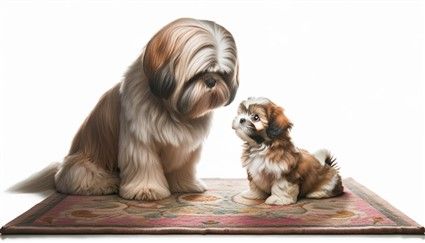
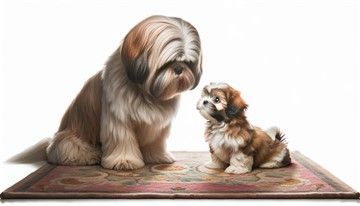
An interesting element to know is that a Shih Tzu puppy is born with all of the hair follicles (the small openings in which each hair shaft grows) that they will ever have. And, Shih Tzu puppies are born with just one layer of hair (the inner layer). As puppies mature, the primary longer hairs will grow in, in the already-present hair follicles. It is for this reason that Shih Tzu puppies have finer, thinner, and shorter coats than their adult counterparts.
When one refers to Shih Tzu puppy shedding, this is actually the transitional phase of a puppy coat changing over to an adult coat. While some hairs will indeed shed off, this is a time of increased hair volume.
Also during this time, it is extremely common for the
coat to change colors as well. Newer hairs may be darker or lighter. And markings may decrease or increase. In fact, if a Shih Tzu adult remains the same color that they were as a puppy, this is the exception and not the rule.
This change-over is most prominent starting at 4 months old and by the time a Shih Tzu is 9 to 12 months old, they will have their adult coat. Do keep in mind that the coat will then continue to grow and renew as normal hairs do.
Normal Shedding with Shih Tzu Dogs:
As discussed, the Shih Tzu is often categorized as a 'low shedder,' primarily because its shedding process is relatively slow. In a healthy coat, only about 10 to 15% is in the catagen phase (the shedding stage) at any given time. This results in minimal shedding. However, it's still crucial to engage in regular grooming to manage loose hairs effectively. Let's take a look at the details:
Disclosure: Please note, some of the links below are affiliate links. This means that, at zero cost to you, we will earn an affiliate commission if you click through the link and finalize a purchase. This helps keep this site running.
Moderate to Long Coats: For Shih Tzu dogs with moderate to long coats, many of the shedded hairs fall back into the coat itself, making shedding less obvious. These hidden hairs, while not immediately visible, can accumulate and must be addressed through grooming.
Short Coats: Shih Tzu dogs with shorter coats experience similar levels of minimal shedding, but the hairs are more likely to fall out of the coat completely. Although less noticeable at first, these hairs can accumulate around the house without regular cleaning.
Importance of Removing Loose and Dead Hairs: Regardless of coat length, removing loose and dead hairs is essential. These hairs can block proper airflow to the skin and trap natural body oils, leading to odors. In moderate to long coats, there's also an increased risk of tangles as dead hairs intertwine with live ones.
Regular Grooming Tasks: Grooming your Shih Tzu not only keeps their coat looking its best but also supports healthy skin. The key grooming tasks include:
- Brushing: This crucial step removes loose hairs from the coat, preventing tangles and keeping the skin free from debris. The frequency of brushing should be tailored to the coat length: Shaved or short coats should be brushed about every 3 days. Longer coat may need to be brushed daily.
- Bathing: Giving a Shih Tzu a bath aids in the shedding process by releasing hairs that are loose but not yet detached from the coat.
Recommended Tools:
- Pin Brush: Ideal for moderate to long coats, selecting a pin brush with 16 mm or 20 mm pins can be most effective. It's important to choose a brush that's compact enough to comfortably access all body parts. The Chris Christensen Little Wonder Pin Brush comes highly recommended for its appropriate size and ease of use.
- Bristle Brush: With shaved or short coats, opting for a bristle brush is advisable. The Safari Small Bristle Brush stands out for its perfect size, ergonomic grip, and high-quality bristles, making it a favorite choice.
- Two-Level Comb: Featuring wide teeth on one side for the body and narrow teeth on the other for delicate areas like paws and the face, a two-level comb is essential for thorough grooming. The Double-Side Comb by PoodlePet is a good choice, offering versatility with its narrow and wide teeth options for comprehensive combing. Its durable metal teeth ensure longevity, making it a valuable tool for grooming around the face, beard, and paws.
In summary, understanding and managing the shedding process through regular grooming is key to maintaining a Shih Tzu's coat. By incorporating routine brushing and bathing into your little guy or gal's grooming regimen, you can keep shedding under control and ensure your Shih Tzu's coat remains healthy and vibrant.
Does the Shih Tzu Have a Seasonal Shed?
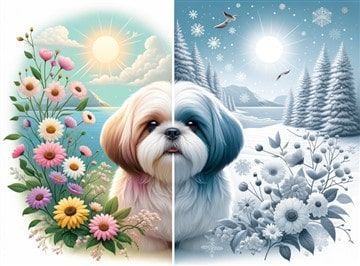
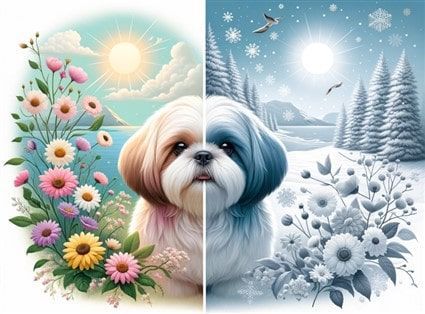
Typically, when one thinks of canine seasonal shedding, one envisions clumps of fur falling out, resulting in a big mess both on the dog and in the house. Fortunately, this is not the case with the Shih Tzu. The Shih Tzu breed experiences a more manageable situation due to their unique, double coats of hair. Shedding may slightly increase due to seasonal changes, primarily influenced by skin health:
Winter: Cold, dry air can lead to dry skin, which may cause more shedding as the hair's integrity weakens. Use moisturizing shampoos and conditioners like Earthbath Oatmeal and Aloe, and consider the use of humidifiers to keep indoor humidity levels optimal, protecting the skin and coat.
Summer: More sun exposure and outdoor activity can also lead to a minor increase in shedding due to hair weakening. Apply a coat spray like Chris Christensen Ice on Ice Spritz which has a UV protection sunscreen, for outdoor activities to protect against sun damage.
Pregnancy Shed
A common occurrence in female dogs that just gave birth is having a significant increase in shedding, often referred to as "blowing the coat", which is triggered by hormonal changes during the late stages of pregnancy and whelping. This process can vary greatly among individual dogs, with some experiencing mild shedding and others losing much more hair, leading to a noticeably thinner coat.
Despite the dramatic appearance of this shedding, it is typically temporary, and the coat usually regrows to its normal state without any underlying issues. Proper nutrition and gentle grooming during this period can support healthy coat regrowth. However, if the shedding appears excessive or the coat does not begin to recover as expected, consulting a veterinarian is advisable to rule out any health concerns.
Heavy Sheds with Abnormal Coat Fall
Abnormal heavy shedding and coat loss in Shih Tzu dogs can be a cause for concern, as this breed is typically known for minimal shedding due to their hair-like coat. When a Shih Tzu experiences excessive shedding or noticeable bald patches, it often indicates underlying health issues that require attention.
Factors contributing to such conditions can range from nutritional deficiencies and stress to more serious health problems like hormonal imbalances, allergies, or skin infections. For full details, along with remedies and treatments, read more about this here: Shih Tzu Hair Loss Issues.
The Best Toys for a Shih Tzu - From durable chew toys for teething pups with itchy gums to companion toys for Shih Tzu that spend time home alone, this article covers all the best types of toys and recommendations.
